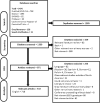Eastern Equine Encephalitis Virus: A Scoping Review of the Global Evidence
- PMID: 33332203
- PMCID: PMC8086401
- DOI: 10.1089/vbz.2020.2671
Eastern Equine Encephalitis Virus: A Scoping Review of the Global Evidence
Abstract
Background: Eastern equine encephalitis virus (EEEV) is a mosquito-borne virus that is primarily found in North America and the Caribbean. Over the past decade there has been an increase in virus activity, including large outbreaks in human and horse populations. Predicted climate change is expected to affect the range of mosquitoes including vectors of EEEV, which may alter disease risk posing a public health concern. Methods: A scoping review (ScR) was conducted to identify and characterize the global evidence on EEEV. A thorough search was conducted in relevant bibliographic databases and government websites. Two reviewers screened titles and abstracts for relevance and the characteristics of relevant articles were extracted using a uniformly implemented data collection form. The study protocol was developed a priori and described the methods and tools used and this article follows the PRISMA-ScR guidelines for reporting ScRs. Results: The ScR included 718 relevant research articles. The majority of the articles originated from North America (97%) between 1933 and 2019. EEEV has been identified in 35 species of mosquitoes, over 200 species of birds, various domestic animals, wild mammals, reptiles, and amphibians. Articles identified in this ScR primarily covered three topic areas: epidemiology of hosts and vectors (344 articles) including surveillance results (138), pathogenesis of EEEV in hosts (193), and in vitro studies characterizing EEEV (111). Fewer articles evaluated the accuracy of diagnostic tests (63), the efficacy of mitigation strategies (62), transmission dynamics (56), treatment of EEEV in hosts (10), societal knowledge, attitudes, and perceptions (4), and economic burden (2). Conclusion: With the projected impact of climate change on mosquito populations, it is expected that the risk of EEEV could change resulting in higher disease burden or spread into previously unaffected areas. Future research efforts should focus on closing some of the important knowledge gaps identified in this ScR.
Keywords: EEEV; eastern equine encephalitis virus; knowledge synthesis; mosquito-borne disease; scoping review; vector-borne disease.
Conflict of interest statement
All authors declare that no competing financial interests exist.
Figures



References
-
- Ackerson LK, Viswanath K. Media attention and public perceptions of cancer and eastern equine encephalitis. J Community Health 2010; 35:409–416 - PubMed
-
- Arechiga-Ceballos N, Aguilar-Setien A. Alphaviral equine encephalomyelitis (Eastern, Western and Venezuelan). Rev Sci Tech 2015; 34:491–501 - PubMed
Publication types
MeSH terms
LinkOut - more resources
Full Text Sources
Other Literature Sources
Medical
Miscellaneous
